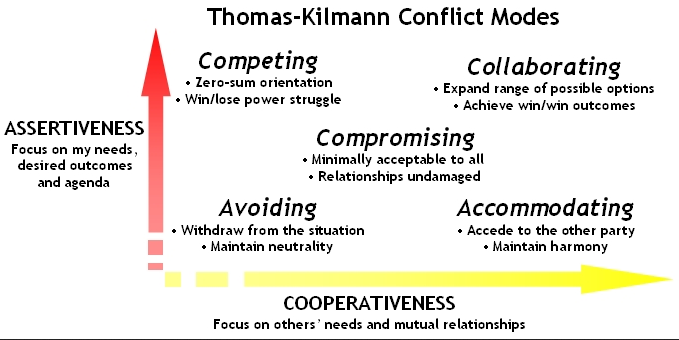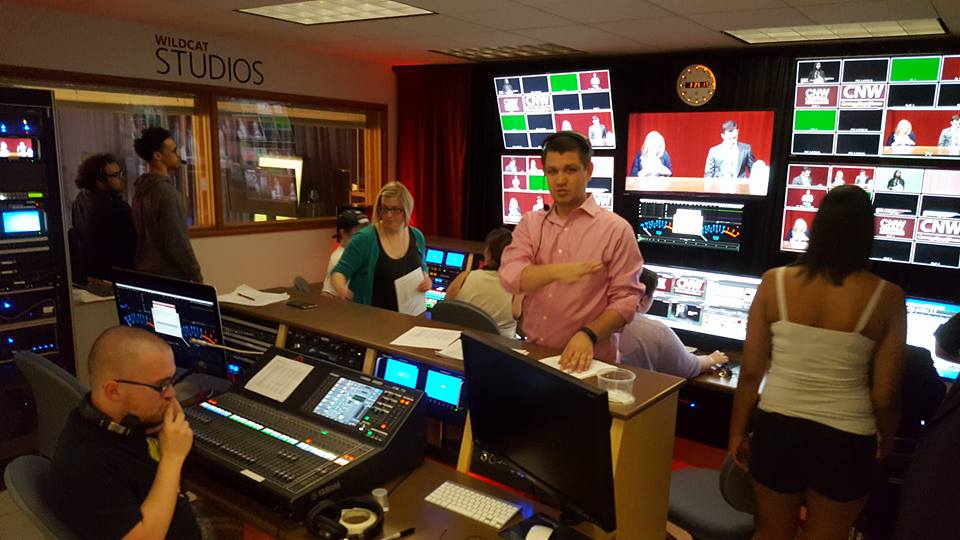Written by Terri Reddout
Conflict.
It’s uncomfortable. It’s energy draining. It’s not fun.
The funny thing is… avoiding conflict is uncomfortable, energy draining and not fun.
Hummmm…
While dealing with conflict may not be one of your favorite things to do, understanding your conflict style and how others deal with conflict can make it easier and more productive.
Would you like a little KTI with your conflict?
KTI is the acronym for the Kilmann-Thomas Conflict Mode Instrument. It’s a way of determining what your mode for dealing with conflict is.
One side of the instrument considers how assertive you are. The other side of the instrument looks at your level of cooperativeness.

Avoiding = I Lose/You Lose situation. If you aren’t very assertive or cooperative you are using the avoidance conflict mode. You don’t want to let the other person know something is bugging you. As a result, the other person doesn’t know there is a problem. You lose because your having to live with the conflict. They lose because they aren’t even aware there is a conflict.
Yet, there are times when avoiding dealing with a conflict is a good move; like when the person you are in conflict with is highly emotional or preoccupied. In that case, it may be wise to avoid the conflict for the time being and deal with it at a more appropriate time.
Competing = I Win/You Lose. If you are extremely assertive and not very cooperative you are using a competing mode of conflict management. Your only goal is to win. That means someone has to lose. Sounds negative. But it can be positive.
Let’s say a toddler wants to play in the street. A parent doesn’t want the toddler to play in the street, especially since a semi truck is headed right at them. The parent uses the competing style of conflict management and grabs the toddler’s arm, pulling the child out of the street. The parent wins by keeping child alive. Toddler loses because he can’t play in the street on that nice yellow line like he wanted.

In a television control room, the director may use a competitive conflict management style during a newscast. When the director wants the button pushed, you push the button. If you don’t push the button, the director will yell and demand you push the button. It’s an appropriate conflict management style during a stress-filled, every second counts newscast. If you don’t push the button the audience won’t get to see the live remote reporter reporting, that means the audience doesn’t get the information, the anchors look stupid and the timing for the newscast is all out of whack.
Now, if the director used that same style of conflict management two hours before air time, that wouldn’t be an appropriate. That would just be being an a**.
Compromise = I win some & I lose some/You win some and you lose some. If you are moderately assertive and moderately cooperative you’re using a compromising form of conflict management. Frankly, this is the mode I believe most people think of as a solution to a conflict situation. The problem with compromise is you have to give up something in order to gain something. So, you win some but you also lose some. On the other side, your opponent will lose some things in order to gain others. They lose some and you win some. When using a compromising approach you have to remember, you will be giving up something in order to resolve the conflict.
Accommodating = They win/You lose (for now). When you are extremely cooperative and not very assertive you are using the accommodating approach. Basically, this mode of conflict management puts the needs of others before your own needs. It’s a form of appeasement.
One dramatic example might be when Spock dies in Star Trek: Wrath of Khan. The conflict is the Enterprise needs to get warp speed in order to escape the Genesis Effect. Because time is of the essence, Spock accommodates and exposes himself to radiation in order to get the engines back on line and save the Enterprise. Kirk runs to the chamber to speak to his dying friend. Spock tells him not to grieve, because what he did was logical. “The needs of the many outweigh the needs of the few,” he says. Spock accommodated by putting his needs aside for the greater good.
Now, you don’t have to die to accommodate. (As it turns out Spock wasn’t dead for that long anyway.) In fact, businesses often take an accommodating approach to conflict when a customer has a problem.
On a recent visit to see my son in Portland, I ended up with a lackluster Cobb salad for dinner. (I don’t know how you can screw up a Cobb salad, but this restaurant did.) I mentioned something to the waitress, she told the manager, the manager spoke with me and then deleted the cost of the salad from my bill.
He chose this short-term mode of conflict management in hopes I wouldn’t bad mouth the restaurant and in hopes I’ll come back again. (I have, but I did NOT order the Cobb salad.) Now, if I kept showing up at his restaurant and complained about my food each time, the manager would eventually get wise and stop accommodating me. (He may even call the cops!)
Collaborating = You win/I win. Aw, we save the best for last. Collaborating is both an extremely assertive and extremely cooperative. Both sides work toward an agreement that satisfies both parties concerns.
Now, this isn’t the conflict management style I’d use when my family and friends can’t decide what restaurant to go to. I wouldn’t suggest it as a method for you and your roommates to determine who has to take the trash out before the party starts. But when the problem is big enough and each party has a lot on the line, collaboration can be an excellent mode of conflict management. The problem is, collaborating takes time and effort.
When working on the educational video series I collaborated with several groups. Each group had an objective.
- The professors wanted to get the information across accurately.
- The teachers wanted a product they knew their students would pay attention.
- The users, the high school students who eventually watched the series, wanted something that showed them this information impacted them and the video wouldn’t put them to sleep.
- I, as the video producer, needed to find ways to demonstrate these topics while staying within a budget while working with equipment limitations. (I did not have a Go-Pro, they didn’t really exist at the time, but I sure could have used one!)
- Another group, the agency that funded us, wanted a product that equaled the level of funding they were giving us.
For each unit the professors would lay out the learning objectives. I spoke to the teachers to find out what possible situations would be relevant to their students. I had to amend my script to more accurately communicate the concept.
For example, the professors wanted me to record a subcontractor’s meeting at a hospital construction project in order to capture examples of the roles people play in a group. We didn’t have enough microphones and because we never knew who was going to speak next we didn’t get examples of each of the roles the professors wanted. We ended up using the examples we had and then using hypothetical situations to explain the other roles we couldn’t capture.
The high school students who worked for me, learned it was part of their job to let me know if anything in the script or video was corny, dorky or cheesy.
In the end, we got so good at it that we won two awards from the university for outstanding collaboration. (Yeah, I’m proud of those awards. We earned them.)
What’s your go-to conflict management style?
Each of us naturally navigate toward a particular conflict management style. In some situations I use the competitive mode of conflict management, in other situations I’ll compromise. I try to handle classroom conflicts through collaboration. We look at the problem by considering the obstacles faced by the students and the goals I need to achieve. Together we reach an agreement. When that decision is made, my students tend to “buy into it” because they had some say in the decision making process.
Now, if they suggest I skip the next two reading assignments, I might use a different conflict management style entirely.
The benefits of dealing with conflict
Believe it or not, there are benefits with dealing with conflict. At a concrete manufacturing company in Utah, WR White Supply, had conflict between the floor staff and middle management. Neither side was talking with each other, projects didn’t get done and the company starting losing money and their reputation.
The company hired one of my colleagues to give everyone tools for handling conflict. It took some time, but they ironed out their problems. An additional benefit was, because they had a method for dealing with conflicts in place, new conflicts were less often and resolved more quickly.
There are lots of benefits to dealing with conflict. It’s one of the ideas I want you to ponder for this assignment.
The assignment
So, think of someone you admire. Or, think of someone you don’t admire. What TKI conflict management style do they normally use? How effective or ineffective is it? Why?
What’s the TKI conflict management style you naturally gravitate toward? What conflict management style do you need to strengthen?
I shared an example of how dealing with conflict can be beneficial. What do you see as some of the benefits in your own life?
If you need more clarification on conflict management styles I suggest re-reading pages 166-170 of your textbook. The video below offers another look at the KTI model and how it works. (Run time: 3:14)
Go to the Blog#8: Conflict post your substantive answers.
This assignment is worth 30 points:
- 10 points for your answer about another person’s conflict management style.
- 10 for your answers to the questions about your own conflict management style
- 10 points for what you see as some of the benefits of dealing with conflict
